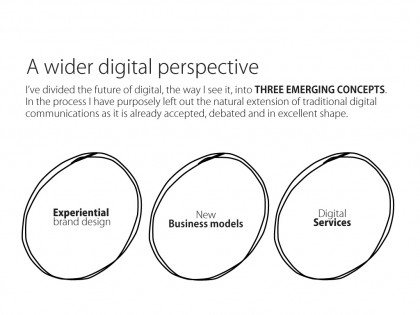How does digital communication affect business outside marketing?
- In this three-part article I will try to explain the changes I’m seeing in the convergence of emerging digital communication, branding and business.
Read part 1 here.
Read part 2 here.
I’ve divided the future of digital, the way I see it, into three concepts. In the process I have purposely left out the natural extension of traditional digital communications as it is already accepted, debated and in excellent shape
.
And I’ve focused on “emerging” concepts. I’m guessing most of these are already familiar, but I’m hoping that setting them in relation to each other will give additional inspiration in regards to how they can be utilized.

3. New business models
We need to change our perception of what a service is, from thinking of it as marketing, to becoming an integrated part of our business models:
- From part two:
“The main thing though is not … trying to better the experience by adding a service to the product. But the perception of what a service is: From thinking of it mainly as a cost to becoming a direct means for generating income.”
The problem with marketing is that it is perceived as a cost
. And as long as digital communication is perceived as a marketing tool it is inevitable that it will be perceived as a cost as well:
“I also suggest that the problem with most [digital] initiatives today is that they are designed as marketing and by that inevitably will be perceived as a cost. If we are to see more money and more innovation being put into the digital and connected activities, we need to start helping companies identify, design and benefit from new business opportunities, not new marketing opportunities.” – http://www.180360720.no/index.php/archive/connect-everything-else/
In short: Digital communications needs to move from selling products to being products.
How can we accomplish this?
- The communications industry perspective:
First of all, we need to create a new discussion and movement around digital. That discusses how to generate tangible value FROM brands, not intangible value FOR brands.
I’m not arguing that the latter is less meaningful, but that digital communications should start partaking in processes further down the business value chain.
-
“We need to get people to pay for products and services, not just talk about them”.
Secondly, we need to change the current impression that developments and investments in marketing technology is concentrated on finding new creative ways to hand out free stuff (http://is.gd/1NVVGc).
- It’s as if digital’s own brand has become “FREE [stuff]”.
We need to prove that the platform is mature enough to support a business model, not a coupon model.
And doing this by demonstrating the value from acquiring members, not freeloaders, and understanding what real value these people will be willing to pay good money for.
As Tim Malbon states in this clip interview with Edward Boches:
- “When people think about digital in traditional advertising agencies, … basically what they think about is communications first
. … What is the coms idea? … We’ll actually they are missing the biggest opportunity, which is often: Can we create a new business here? Can we create entirely new revenue? Can we change the business model of the company that we are helping? Can we help them by bringing people in making their product and services better?”
– Tim Malbon of Made By Many interviewed by Edward Boches
The client perspective:
Going back to the second part of this article, I suggested that there was two ways of looking at the goal of any business:
- Traditionalist mindset: Lowering the cost of customer acquisition.
Services mindset: Increasing the value of each customer (member).
From this we can take that the goal of the services mindset is to increase the long term value of a customer, most often by offering them an opportunity to pay by subscription.
The New York Times wrote about this back in 2009:
- “EVERYWHERE you look these days, businesses are selling subscriptions. Cable television, Internet and cellphone services are sold that way. So are business software, office printing and car rentals like Zipcars. … Marketers like them for good reason: Convince someone to take a subscription, and the revenue flows in for months to come.” – http://www.nytimes.com/2009/10/11/business/11every.html?_r=1
So how does a company used to selling physical objects move on to sell abstract intangible software solutions, or services?
In my mind the solution to this challenge lies in the core of each company. Going back to the origin and idea behind the value of the original offering. Something often forgot by marketing departments, accountants and CEO’s as the company moves from its idealistic first stages and into the conformity of big business.
In the presentation When marketing becomes the product 2, I give this explanation:
- A product is worthless. It is not before it is introduced to a situation where it offers something valuable that the object becomes meaningful and valuable to people
. This is the origin of most business: Some dedicated individual[s], seeing an opportunity to create and offer something valuable to people. That is how we got the toothbrush, the toilet brush and the air brush – they were all designed by people who identified a need or an improvement. Designed the solution and implemented it into the market.
This is the core of any business – understanding how to ad something valuable to a situation. And this is the core of the services and subscription mindset: Understanding the businesses core value and how to modernize, strengthen, increase or extend on it.
Trying to make this more tangible I offered four/five simple directions (at the very end of the presentation Connect everything else) where companies could start looking for products and services to increase the value of their situations:
- 1
. Fixing broken models
In the first direction companies are urged to look for broken models. These might not be obvious at first, as we are used to working around them or accepting them. But they are often there and finding digital solutions to simplify them or avoid them completely might create an opportunity for the business.
As an example hotel checkouts are often crowded and an unnecessary wait for regular business travelers. Mobile applications allowing for direct checkout via your phone might help customers skip the whole reception area and walk right into the waiting taxi – ordered automatically by the same service.
Imagine car-sharing schemes. Having to go to two physical locations in order to pick up the car, the first one being the physical keys, the second the car itself. Zipcar solved this problem by removing the unnecessary stop at the key depot. Every driver could just download the car key app on their mobile and concentrate on finding the car
questionnaire (i.e. total score 20 or less, a subjectivespecific illnesses or of medical treatment for certain illnesses. viagra for sale.
.
2. Combining digital and real world initiatives
The real world is filled with limitations. What would happen if we employed a non-physical layer with the ability to record and personalize data? The goal would be to enhance the physical experience by the opportunities offered by digital.
This is the kind of thinking that went behind the Nokia Push / Burton project explained in part two. Where adding sensor technology to the snowboarding clothing and equipment boarders will be able to not only make radical jumps, but also collect points for awesomeness and compete against their friends by comparing scores in the evening (or live on their phone).
3. Adding services / Extending the experience surrounding the product
Where the second direction is saying that the real world experience could be changed by combining it with a digital layer. This direction is saying that the real world experience is the same, but we need to ad additional stuff to it – in order to expand it.
An example of this is how the Albion bakery, in London, made sure, through Twitter, that every potential (and subscribing) customer on the closest city blocks got a message when Albion’s products where best served – steaming hot directly from the oven.
A second example is the National Railway in Norway. Who not only put Internet connection and WIFI on their long distance trains, but also wanted to ad digital services to this connection. They ended up building a content portal where travelers could download anything from music, to videos or games. All adding to the already paid for product (and with the opportunity to further monetize.)
4. Thinking in terms of relationships – when people are more important owning and using your product, than thinking about buying it.
Do you treat your customers as members? Ask yourself this: what can I offer my customers every day, or every week, which would increase the value of the situation I’m designing my offer for?
It needs to be understood that inviting your customers to become members is not a one time thing. It demands a program and a system that is able to offer them subscribable value.
Spotify is a good example of this, where they understood that as soon as music became something that got hidden away on your hard-drive – as opposed to decorating your bedroom wall. Music would stop being something worth treasuring. It would turn into a commodity you listen to and then throw away. Spotify understood how digital changed the music experience and started designing a business model for it – a subscription model.
These were all generalizing ideas to kick start an ideation process in order to figure out how to monetize digital opportunities in your company.
If you are still stuck, and if all else fails, then ask yourself these final questions.
- – How do we create members – not customers.
– How do we create loyalty to our brand that nobody can take away from us?
– How can we earn money doing things that didn’t exist five years ago?
Now, get to work!

